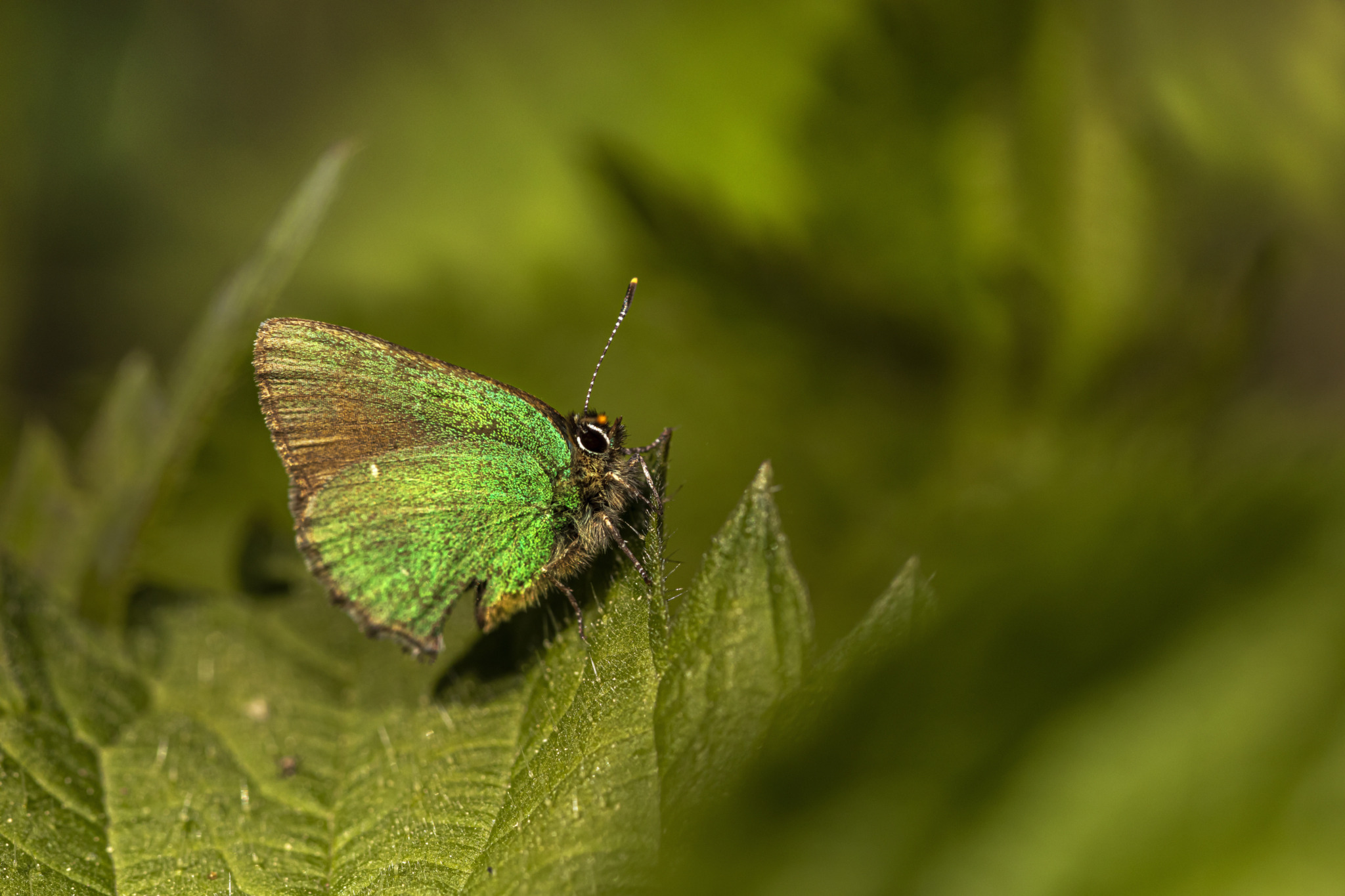Here’s a detailed overview of the Green Hairstreak (Callophrys rubi), one of Europe’s most beautiful and widespread small butterflies.
🦋 Green Hairstreak (Callophrys rubi)
Taxonomy
- Kingdom: Animalia
- Phylum: Arthropoda
- Class: Insecta
- Order: Lepidoptera
- Family: Lycaenidae
- Genus: Callophrys
- Species: C. rubi
Common names: Green Hairstreak
Scientific name: Callophrys rubi
General Description
The Green Hairstreak is a small, shimmering green butterfly that is widespread across Europe and Asia. Its distinctive emerald-green underwings make it one of the most easily recognized hairstreaks, though the uppersides are rarely seen as it rests with closed wings.
- Wingspan: 25–30 mm
- Upper side: Dark brown (seldom visible in rest)
- Underside: Bright metallic green with a thin, faint white streak (often broken or absent)
- Body: Small, compact, covered with fine hairs
- Antennae: Black with white rings and orange tips
Distribution and Range
The Green Hairstreak has a wide Palearctic distribution, extending from western Europe to Siberia and northern China.
Found throughout:
- Most of Europe (except far northern Scandinavia)
- North Africa (localized)
- Middle East and Central Asia
- British Isles (fairly common in uplands and heathlands)
In northern latitudes, it inhabits lowlands, while in southern and central regions it occurs in upland areas up to 2,000 m.
Habitat
Prefers sunny, sheltered habitats such as:
- Heathlands and moorlands
- Woodland clearings and edges
- Grasslands and scrub
- Coastal dunes and slopes
- Mountain meadows and limestone hills
Key habitat feature: Presence of larval host plants and warm microclimates with sparse vegetation.
Behavior
- Flight period: April to July (earlier in the south, later in the north)
- Generations: Usually one per year (univoltine)
- Activity: Active in sunshine; males perch in open sunny areas to defend territories.
- Resting posture: Wings always closed, showing green undersides.
They are strong fliers and frequently perch on shrubs, branches, or heather stems.
Diet
Adults: Feed on nectar from a variety of flowers, including:
- Gorse (Ulex europaeus)
- Bird’s-foot trefoil (Lotus corniculatus)
- Bugle (Ajuga reptans)
- Dandelion (Taraxacum officinale)
- Bluebell (Hyacinthoides non-scripta)
Larvae (caterpillars): Polyphagous – feed on buds, leaves, and flowers of many shrubs and herbs, such as:
- Common gorse (Ulex europaeus)
- Broom (Cytisus scoparius)
- Bilberry (Vaccinium myrtillus)
- Buckthorn (Rhamnus cathartica)
- Bird’s-foot trefoil (Lotus corniculatus)
- Genista and Hippocrepis species
Life Cycle
- Egg:
- Small, greenish-white, laid singly on flower buds or young shoots.
- Hatches after 1–2 weeks.
- Larva (caterpillar):
- Flattened, slug-like, bright green with darker dorsal lines.
- Feeds openly but camouflaged against foliage.
- Pupa (chrysalis):
- Brownish; formed in the leaf litter or soil at the base of plants.
- Overwinters in this stage.
- Adult:
- Emerges in spring and flies for 2–3 months depending on climate.
Identification Summary
| Feature | Description |
|---|---|
| Scientific Name | Callophrys rubi |
| Common Name | Green Hairstreak |
| Wingspan | 25–30 mm |
| Color (underside) | Shimmering green |
| Color (upperside) | Dark brown |
| Flight Period | April–July |
| Generations | One per year |
| Habitat | Heathland, scrub, woodland edge |
| Host Plants | Gorse, broom, bilberry, trefoil |
| Overwintering Stage | Chrysalis |
| Conservation Status | Least Concern |
Predators and Threats
- Birds, spiders, and parasitic wasps prey on caterpillars.
- Habitat loss through intensive agriculture, forestry, and scrub removal.
- Pesticide use and loss of nectar plants reduce adult numbers.
Conservation Status
- IUCN Red List: 🟩 Least Concern
- Trend: Stable, but local declines in some regions due to habitat loss.
Conservation measures:
- Maintain heathlands, open woodlands, and scrub areas.
- Encourage native host plant growth.
- Reduce pesticide use and overgrazing.
Interesting Facts
- The green color of its wings comes from structural coloration, not pigment — light interference from microscopic wing scales creates the emerald tone.
- Males are territorial and can be seen “perching” to defend sunny spots.
- Despite its vivid color, it is remarkably well-camouflaged when resting among green leaves.
- It’s the only green butterfly found in much of Europe.
Ecological Role
The Green Hairstreak plays an important role as a pollinator and as part of the food web supporting insectivorous birds and spiders.
Summary
The Green Hairstreak (Callophrys rubi) is a vibrant, small butterfly with dazzling green underwings, common across Europe and Asia. Thriving in heathlands, grasslands, and sunny forest edges, it is both adaptable and resilient. Its single annual generation emerges in spring, feeding on a variety of nectar plants and breeding on shrubs such as gorse and bilberry. Despite being small, it is a jewel of springtime landscapes and a key indicator of healthy semi-natural habitats.
Views: 1463
Subscribe to the newsletter:
